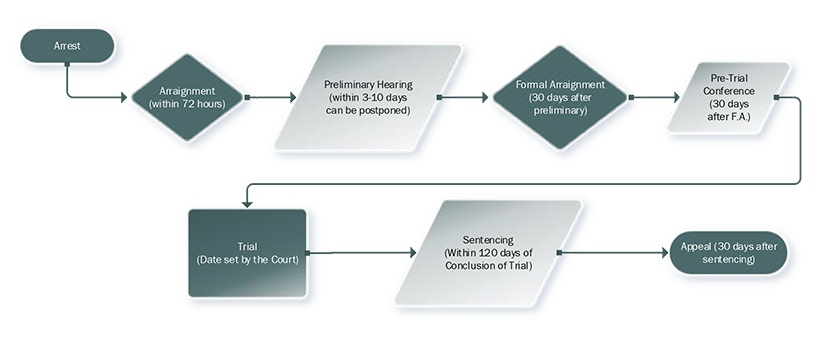CRIMINAL JUSTICE FLOW CHART
Arrest Made
Accused brought to central intake center because:
Caught committing a crime or alleged probable cause
Arrest warrant or bench warrant was issued
Alleged probation or parole violation
Contempt of court order
Those confined on bench warrants or contempt orders have a hearing within 72 hours of arrest. Those confined on probation allegations will be scheduled for a “Gagnon 1” hearing before a hearing officer to determine if there is probable cause to continue detention.
The flow-chart below pertains to those accused of new crimes.

Arraignment [within 72 hours of arrest] – for those charged with committing crimes
Takes place in front of a magistrate
Bail is approved or denied and, if approved, bail conditions are set
Opportunity is given to post monetary conditions of bail, if imposed
Public Defender interviews the accused, usually in the visitation room.
Preliminary Hearing [scheduled within 3 to 10 days, but can be postponed]
Magistrate determines if enough evidence to prove it is more likely than not a crime was committed and that it is more likely than not that the accused is the actor who committed the elements of the crime; if so, the case held for trial.
The court must presume that the witness(es) is/are telling the truth; defense does not present its evidence.
Hearing may result in dismissal of case, reduction of charges, or assessment of a fine.
A motion for bail reduction can be made at this hearing
Sometimes the hearing is continued at the prosecution’s request if a witness doesn’t show up
Incarcerated persons will be seen by the Public Defender at the Preliminary Hearing.
Some people charged with minor offenses may be candidates for the District Attorney’s ARD program – an attorney can assist with the application.
Formal Arraignment [approximately 30 days after final preliminary hearing]
Incarcerated person generally appears via video from the prison.
Court will notify the accused of the charges against
Typically one enters a plea of not-guilty
Those who do not have counsel at arraignment can request a public defender
Signing of subpoena giving Pre-Trial Conference date and judge assignment
Pre-Trial Conference [approximately 30 days after Formal Arraignment]
D.A. and either Public Defender or Court-Appointed Attorney assigned if defendant does not have a private attorney
D.A. should provide defense counsel with discovery
Defendant may enter a plea or request a trial if ready to do so
Defendant chooses jury trial or non-jury trial
Dates maybe set for motions or a subsequent status conference
Trial [date to be set by the court]
Accused may present a defense
Accused will meet with defense counsel in preparation of this date
Believability of witnesses is extremely important
Defendant may be found guilty or not-guilty. In rare instances a mistrial may require a new hearing
If not-guilty defendant to be released if no other holds
If guilty, sentencing date to be set; counsel may request to have a pre-sentence investigation done which normally takes 90 days
Sentencing [Normally within 120 days of conclusion of trial, often sooner]
A person found guilty may be sentenced to any of a number of options, often in combination: fines, restitution, probation, alternative housing, total confinement.
Judges use Sentencing Guidelines to evaluate possible sentence – there can be a very wide range of possible sentences even within the guidelines
Defense can present mitigating facts to argue for sentences at the lower end of the Sentencing Guidelines
Defendant receives notice of post-sentence rights informing them of deadlines to file post-sentence motions and appeals.
Appeal
A person generally has 30 days to appeal a final sentencing order.
[All paper work including order for release must first be in inmate’s file before actual release of inmate from GWH to outside, a program, or another correctional facility.]